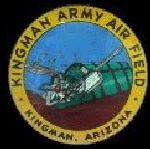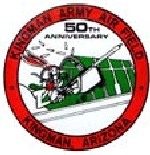2008 - All rights reserved - ArmyAirfieldKingmanMuseum.com

Circa 1943
B-17 Over Kingman Army Airfield
Welcome to the Army Airfield Kingman Museum Online
http://www.ArmyAirfieldKingmanMuseum.com/
Besure and check the Newsletter on the upper Menu bar, we want to keep the public and our membership informed.
|
  |
Our Faithfull Mascot, Bugs Bunny was there, too.
With sanction from Warner Brothers, Bugs was adopted as the official base mascot. The poster of Bugs with fierce countenance, and armed to the teeth for war, was displayed in a most prominent location on the base. On May 7,1943, the facility was officially named the Kingman Army Air Field. The base continued to grow and change during 1943. Many new squadrons were added to the base and some of the existing ones were combined. The 1120th and the 329th merged with the 328th to become the 328th Flexible Gunnery Training Group.
The 1122nd, 537th, and 538th were consolidated to form the 1123rd Flexible Gunnery Training Group. The 1121st became the 329th. The 536th and the 760th Flexible Gunnery Training Groups were added to the list. Also assigned to the B17 fighting groups was the 31st altitude squadron, training for operations at high altitude.
|
Thirty six thousand gunners trained at the Kingman Army Airfield during World War Two.
In 1943, the facility was officially named the Kingman Army Air Field.
On January 2,1944, a B17 disintegrated in bad weather. Of the thirteen men killed in the resulting crash, eleven were from Kingman.
Four days later, a bus loaded with gunnery students bound for the base, crossed the railroad tracks just north of the entrance. The driver did not see the oncoming train. Train and bus collided, and twenty-eight students died.
The war ended in 1945. With peace in the world, there was no further need for a gunnery school. Or for the airplanes that carried the guns.
In 1946 the training base became Storage Depot 41. The intent was to render thousands of airplanes down to aluminum ingots. Kingman was one of five sites chosen for the task. The job was finished by 1948. Seventy million pounds of aluminum from seven thousand airplanes were shipped out of Kingman.
A relatively few of the airplanes escaped destruction, and some are still flying today. Others rest in the museum to be viewed by people who do not remember, or who do not understand the meaning of what they are seeing.
In July 1948, the Military released the base for civilian use, and it became a property of Mohave County.
By courtesy of Mohave Museum of History and Arts.
Partners:
www.agmglobalvision.com